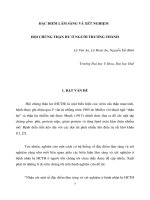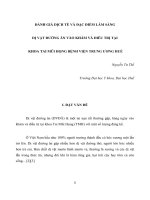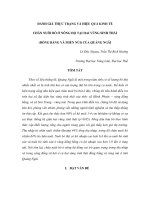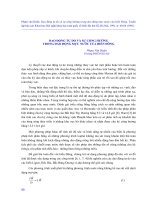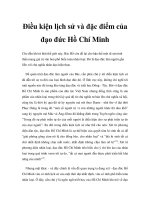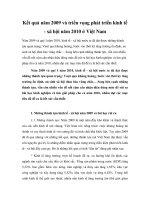Báo cáo nghiên cứu khoa học: "Tỷ lệ nhiễm HIV và các yếu tố gây nhiễm giữa những người bị nhiễm HIV tại ỉnh Chiang Rai, Thái Lan" potx
Bạn đang xem bản rút gọn của tài liệu. Xem và tải ngay bản đầy đủ của tài liệu tại đây (74.99 KB, 10 trang )
403
JOURNAL OF SCIENCE, Hue University, N
0
61, 2010
PREVALENCE OF HIV INFECTION AND RISK FACTORS OF TUBERCULIN
INFECTION AMONG HOUSEHOLD CONTACTS
IN AN HIV EPIDEMIC AREA: CHIANG RAI PROVINCE, THAILAND
Pornnapa Suggaravetsiri
Khon Kaen University, Thailand
Juthatip Putthasorn
Chiang Rai Prachanukraow Hospital, Chiang Rai Province, Thailand
SUMMARY
During the course of the HIV epidemic in Chiang Rai Province in Northern Thailand,
incidence of tuberculosis also sharply increased. Up to the year 2002, there were no specific
interventions for the prevention and control of TB infection among the household contacts of an
infected person. The study aimed to identify prevalence of HIV infection and risk factors of
tuberculosis infection among household contacts. Methodology: A cross-sectional analytic study
was conducted among household contacts of TB cases between January 2001 and January 2002.
We collected data using structured interviews, physical examinations, tuberculin skin test (TST),
mumps skin test and pre-test and post-test counseling for HIV testing. Results: The prevalence of
positive tuberculin skin test among 1,211 household contacts was 57.55% and the HIV positive
rate among household contacts was 7.74% (72 out of 930 contacts who did agree to HIV
testing). Based on the variables entered into the model, gender, age, HIV status, caregivers of
TB patients and living in the same room as the infected patient were significantly related to TB
infection. However, the presence of a BCG scar was not significantly associated with TB
infection. Conclusion: TB screening every 6 months should be provided to household members
and children who had contacts with HIV positive individuals and the introduction of anti TB
prophylaxis should be provided to HIV infected persons.
Keywords: Tuberculosis, Households, Risk factors, HIV, Thailand
1. Introduction
Tuberculosis (TB) and Human immune deficiency virus (HIV) are currently the
major leading causes of death worldwide among infectious diseases. It is estimated that
TB kills more than two million people each year. This problem is further aggravated by
the alarming spread of HIV and the emergence of drug resistance. According to WHO
estimates there were 8.8 million new case of TB in 2003 (140/100,000) of which 3.9
million (62/100,000) were positives smear and 674,000 (11/100,000) were infected with
404
HIV. Annually 5% to 15% of HIV- positive individuals develop TB and at least one-
third of the world population, that is about 1.9 billion people are infected with TB.
Within Chiang Rai province in Northern Thailand, 1990-1998 data revealed that the
proportions of TB cases attributable to HIV was 72% among males- and 66% among
female patients. The TB notifications increased from 40/100,000 population in 1990 to
144/ 100,000 population in 2002, which amounted to a three- fold increase in TB. This
was mostly attributable to HIV. Obviously the problem of TB/HIV is an issue of critical
importance, and challenging for investigation and control. Several studies were
conducted to explored risk factors among TB patients, household members, and health
care workers. However, most of them investigated the risk factors relating to the
development of TB rather than its source of infection. This study aimed to identify the
risk factors of TB infection among household contacts in a HIV epidemic area, Chiang
Rai province, Thailand.
2. Methodology
A cross- sectional study was carried out between January 2001 and January 2002.
Three hospitals located in the epidemic area of Chiang Rai Province, Chiangrai
Prachanukroa, Phan and MaeJan, were the study sites. Tuberculosis index cases (the
first suspected case in each household) were diagnosed by chest radiography (CXR) and
tested for acid-fast bacilli (AFB) in sputum. TB index cases and the household of each
TB index case were visited by a researcher assistant. Household contacts were defined
as members of an extended family of the index case who lived in the same house as the
TB index case. Specific information about TB infection from the household contacts
was collected by their response to a list of typical clinical symptoms of TB. Physical
examination, mumps skin test and a tuberculin skin test (TST) were performed at the
hospital or at home by well trained nurses. Indurative diameters of mumps skin test and
the TST were measured within 48 to 72 hours. An indurative diameter of ≥ 10 mm of
TST was considered to be a positive test (TB infection). Double data entry by using the
software of Epi-info Version 6.02 (Atlanta, USA) was done to validate the data. The
data file then was transferred to STATA 7.0 (Texas, USA) for statistical analysis to
calculate the proportion of infection among household contacts and examine the effects
of different factors related to the TB infection. Multiple Logistic regressions were
carried out by the backward elimination method. The study was approved by the Ethics
Committee of the Public Health Ministry of Thailand.
3. Results
From the 526 TB index cases, 221 (42.01%) were TB/HIV- positive and 305
(57.98%) were TB/HIV- negative. Among 1,300 household contacts were identified,
1,248 household contacts consented to participant in the study. Of these 1,240 (99.36%
of 1,248) agreed for TST and 930 (74.52% of 1,248) consented for HIV testing.
Twenty-nine persons were excluded because of an allergy to TST. The remaining 1,211
405
study participants were included in the analyses. The sex ratio between males and
females was almost one to one. There were 690 (56.98% of 1,211) with tuberculosis
infection. Of those 366 (30.22%) were children younger than 14 years with TB infection.
There were 930 HIV testing results among household contacts, of which 72
(7.74% of 930) were HIV positive and 685 (56.56 %) had a BCG scar. Using a
univariate analysis, the risk of being TST- positive was found to be higher among
household contacts of HIV negative- than HIV positive index cases. The risk of
household contacts of developing a positive TST response was associated with the TB
index cases and elaborates demographic variables. A low educational status increased
the risk of TB infection. Household members being involved in agricultural and trade
activities had higher risks of acquiring TB compared to government officers. To be a
student was a protective factor of having the infection. Married and divorced family
members were more at risk of infection than those who were never married. Among the
family members, spouses had a higher risk of having the infection than other family
members of the index cases (Table 1).
Table 1. Rate and odds ratio of tuberculin skin test (TST) positive and characteristics of
household contacts
Characteristic
Number and Prevalence
(%) of TST-positive
Crude
odds ratio
95% CI
p-
value
Sex
male 327/528 (61.93) 1.00
Female 363/683 (53.15) 0.51 0.40-0.65 <0.01
Age (years)
<10 75/239 (31.38) 1.00
10-19 111/189 (58.73) 3.11 2.09-4.63 <0.01
20-29 107/146 (73.29) 6.00 3.80-9.48 <0.01
30-39 119/171 (69.59) 5.00 3.27-7.66 <0.01
40-49 103/148 (69.59) 5.01 3.21-7.80 <0.01
50-59 82/124 (66.13) 4.27 2.69-6.77 <0.01
≥ 60 93/194 (47.94) 2.01 1.36-2.98 <0.01
Race / Ethnicity
Thai 639/1126 (56.75) 1.00
Hill tribe 51/ 85 (60.00) 1.14 0.73-1.79 0.56
406
Education
More than high
school
126/196 (64.29) 1.00
No education 209/431 (48.49) 0.52 0.37-0.74 <0.01
Elementary 355/584 (60.79) 0.86 0.62-1.21 0.38
Occupational
Government official 138/253 (54.55) 1.00
Agriculture & Trade 219/318 (68.87) 1.84 1.31-2.60 <0.01
Labour 175/251 (69.27) 1.92 1.33-2.77 <0.01
Student 158/389 (40.62) 0.57 0.41-0.78 <0.01
Marital status
Single 244/508 (48.03) 1.00
Married 358/558 (64.16) 1.94 1.52-2.48 <0.01
Divorced 88/145 (60.69) 1.67 1.15-2.43 <0.01
Relationship to Index case
Relative 179/366 (48.91) 1.00
Spouse 203/282 (71.99) 2.68 1.93-3.74 <0.01
Children 121/238 (50.84) 1.08 0.78-1.50 0.64
Parent 187/325 (57.54) 1.42 1.05-1.91 0.02
Alcohol drinking and smoking were associated with a risk of having infection
than non- drinkers and non-smoker. The presence of a BCG scar was a protective factor.
Variables that had a close contact with the index case, such as giving care to them,
sleeping in the same bedroom and sleeping in the same bed as the index case, were
associated with an increased risk of being infected with TB (Table 2).
Table 2. Univariate analysis of risk factors associated with tuberculosis infectious among
household contacts
(1)
Variable TST positive
TST
negative
OR 95 % CI p-value
Alcohol drinking
No 577 478 1.00
407
Yes 113 43 2.18 1.50-3.16 <0.01
Cigarette smoking
No 449 380 1.00
Yes 241 141 1.45 1.13-1.85 <0.01
BCG scar present
Positive 411 274 1.00
Negative 279 247 0.75 0.60-0.95 <0.01
HIV status
Positive 22 20 1.00
Negative 539 316 1.55 0.83-2.87 0.17
Care giver to the TB patient
No 376 406 1.00
Yes 314 115 2.95 2.83-3.81 <0.01
Sleeping in the same bedroom as the
TB patient
No 379 362 1.00
Yes 311 159 1.87 1.47-2.37 <0.01
Sleeping in the same bed as the TB patient
No 448 395 1.00
Yes 242 126 1.69 1.31-2.18 <0.01
Open the window
Everyday 479 371 1.00
Seldom 75 62 0.94 0.65-1.35 0.73
Never 136 88 1.20 0.89-1.62 0.24
Note:
(1)
Total may not be equal to 1,211 due to missing data.
OR = 1.00 is the reference group for each category
A multivariate model was fitted to assess the potential confounding factors and
other factors, age and sex, BCG scar present, HIV status of contact, care giver of the TB
patient, and sleeping in the same bedroom as the TB patient. A potential confounder was
only the age group; the multivariate analysis was done to test the magnitude of the
408
single factor to develop TB infection. If this was true then the R
2
value would be
additional valuable information as it would show the magnitude of how much a given
variable determined the variation of the dependent variable or the infection with TB
among the household contacts. The factors significantly related to being TST positive
were being male, older age, and being in close contact to the TB index cases. The
presence of a BCG scar was not a risk factor for TB infections among household
contacts (Table 3).
4. Discussion
This study found that more than 50% of the household contacts of people with
TB and HIV were infected with TB. This was lower than studies conducted in Sub-
Saharan Africa but higher than studies conducted in other regions. The differences
between this study and those undertaken in other areas could be due to the use of
different methods for identification of cases and family relationships. It was not known
whether poverty could lead to poor nutrition and low immunity of people when they led
to varying degree of risk of having the TB infection. One unexpected result was that
those household contacts to an index case who were HIV negative had a higher risk of
having TB compared to household contacts with an index case who was HIV positive.
The reason for this probably was that household contacts knew the HIV positive status
of the index case and had prevention in close contact with the HIV infected person.
Household contacts with HIV negative index cases might not take that precaution. The
level of TST indurations of a person with previous BCG immunization ranged from 5.0
mm to 11.3 mm even without natural infection. Another possible explanation to the
contradictory finding was that a high degree of illness in HIV-infected patients could
result in weaken and perhaps less effective dissemination of M. tuberculosis the
patients’ environment. In addition, HIV-infected persons probably had a compromised
ability to react to tuberculin skin testing, because HIV infection is associated with an
elevated risk of skin test allergy.
Table 3. Risk factors associated with tuberculosis infection among household contacts of TB
index cases (Multivariate analysis)
Variable Adjust OR
(2)
95 % CI p-value
Sex
Male 1.00
Female 0.45 0.33-0.61 <0.01
Age (years)
<10 1.00
10-19 3.70 1.89-7.25 <0.01
409
20-29 6.45 3.21-12.96 <0.01
30-39 5.34 2.70-10.57 <0.01
40-49 5.55 2.79-11.05 <0.01
50-59 6.26 2.99-12.87 <0.01
≥ 60 2.56 1.29-5.08 <0.01
BCG scar present
Positive 1.00
Negative 0.74 0.53-1.04 0.08
HIV status
Positive 1.00
Negative 3.15 1.57-6.33 <0.01
Care giver to the TB patient
No 1.00
Yes 2.04 1.48-2.81 <0.01
Sleeping in the same bedroom as the TB patient
No 1.00
Yes 1.99 1.44-2.74 <0.01
Note:
(2)
Variables entered in the Multiple Logistic Regression Analysis were sex,
age, BCG scar present, HIV status, care giver to the TB patient, and Sleeping in the
same bedroom as the TB patient similar to other studies, the risk of having positive TST
was related being male and older age group. Males might be less careful and less aware
of the danger in acquiring TB. The decreasing immune stimulation probably was related
to older age and a longer term exposure to TB might contribute an increasing risk
among older age groups. Furthermore, it was found that hill tribe people had a higher
risk to be infected with M. tuberculosis then other Thai citizen. However the difference
between both groups was not significance. Type I error could occur as these were only
85 hill tribe persons included in this study. Other factors such as malnutrition, low
income, poor access to health care, crowding, and poor hygiene were not explored in
this study and required further investigation. Another factor was immune status, which
was found to be lower among hill tribe people as discussed by Wanda Walton and
Patricia Simone. The presence of a BCG scar was not a risk factor for TB infection.
This was similar to what was found in West Africa and might be explained by some
protective mechanism of being exposed to the causative agent of TB. These also require
410
further investigation.
5. Conclusion
The presence of a positive TST result was consistently higher over all ages in
individuals with a BCG scar. BCG vaccination was reported to induce cross-reactivity
with tuberculin PPD (Purified protein derivative), but the degree of tuberculin
sensitivity is highly variable, depending on the vaccine strain used, the dosage, the
method of administration, and other factors known to influence the reaction to TST.
Currently, BCG is given immediately to all babies born in Thailand. The coverage is
more than 95% nationwide. BCG scars consistently had no relationship with TB
infection status. Therefore, the presence of a BCG scar should not be a factor in the
decision-making to treat latent TB infection among children and HIV-infected persons,
as BCG did not appear to prevent the activation of a latent TB infection induced by
HIV-related immunodeficiency.
Household contacts that had been in close contact with the index case included
family members, coworker or friends, and customers as found in other studies. In this
investigation occupational and marital status was an independent risk factor to TB
infection and also family relation, such as being husband or wife, had an impact on the
TB infections of the contacts.
Table 4. A Multiple logistic regression analysis of risk factors associated with tuberculosis
infection among household contacts of TB index cases
Variable Adjust OR
(2)
95 % CI p-value
Sex
Male 1.00
Female 0.45 0.33-0.61 <0.01
Age (years)
<10 1.00
10-19 3.70 1.89-7.25 <0.01
20-29 6.45 3.21-12.96 <0.01
30-39 5.34 2.70-10.57 <0.01
40-49 5.55 2.79-11.05 <0.01
50-59 6.26 2.99-12.87 <0.01
≥ 60 2.56 1.29-5.08 <0.01
BCG scar present
411
Positive 1.00
Negative 0.74 0.53-1.04 0.08
HIV status
Positive 1.00
Negative 3.15 1.57-6.33 <0.01
Care giver to the TB patient
No 1.00
Yes 2.04 1.48-2.81 <0.01
Sleeping in the same bedroom as the TB patient
No 1.00
Yes 1.99 1.44-2.74 <0.01
Note:
(3)
Variables entered in the Multiple Logistic Regression Analysis were sex,
age, BCG scar present, HIV status, Care giver to the TB patient, and Sleeping in the
same bedroom as the TB patient
REFERENCES
1. Narain JP, Lo YR. Epidemiology of HIV-TB in Asia. Indian J Med Res. 2004; 120(4):
277-89.
2. World Health Organization, UNAIDS. Preventive therapy against TB in people living
with HIV.1999.
3. Dye C, Scheele S, Dolin P, Pathania V, Raviglione MC. Consensus statement. Global
burden of tuberculosis: estimated incidence, prevalence, and mortality by country.
WHO Global Surveillance and Monitoring Project. JAMA. 1999; 282(7):677-86.
4. WHO. Global Tuberculosis Control: Surveillance, planning, financing. 2003.
5. WHO. Global Tuberculosis Control: Surveillance, planning, financing. 2005.
6. Annual Report of Chiang Rai Health Office. TB Control Programme. 2004.
7. Tansuphasawadikul S, Amornkul PN, Tanchanpong C. Clinical presentation of
hospitalized adult patients with HIV infection and AIDS in Bangkok, Thailand. J AIDS.
1999; 21(4): 326-32.
8. Lui K.J. Statistical Estimation of Epidemiological Risk. Chichester: John Wiley&Sons
Ltd; 2004.
412
9. Nunn P, Gicheha C, Hayes R. Cross-sectional survey of HIV infection among patients
with tuberculosis in Nairobi, Kenya. Tubercle and lung dis. 1992; 73:45-51.
10. Braun MM, Badi N, Ryder RW, et al. A retrospective cohort study of the risk of
tuberculosis among women of childbearing age with HIV infection in Zaire. Am Rev
Respi .Dis 1991; 143:501-4.

